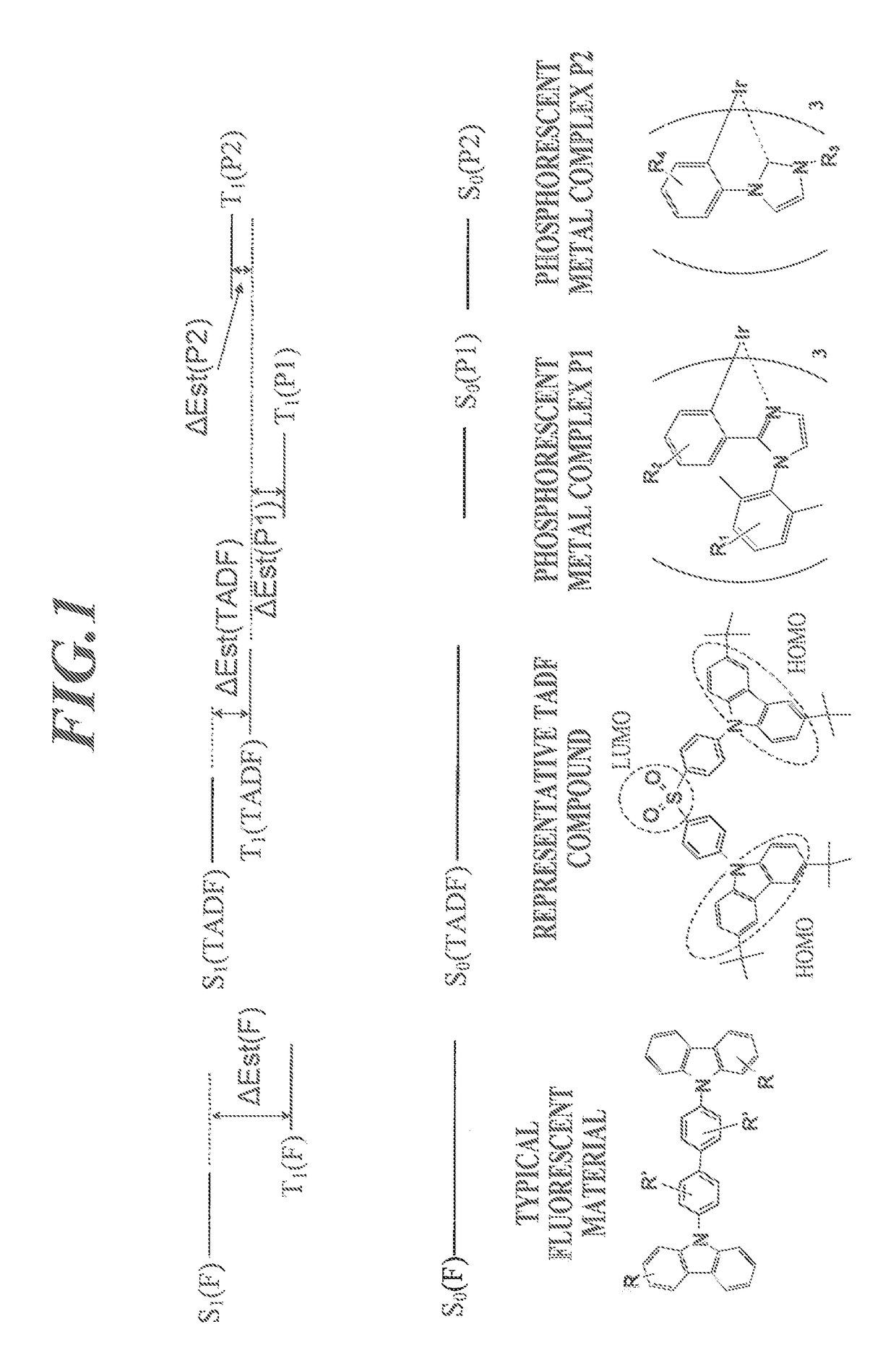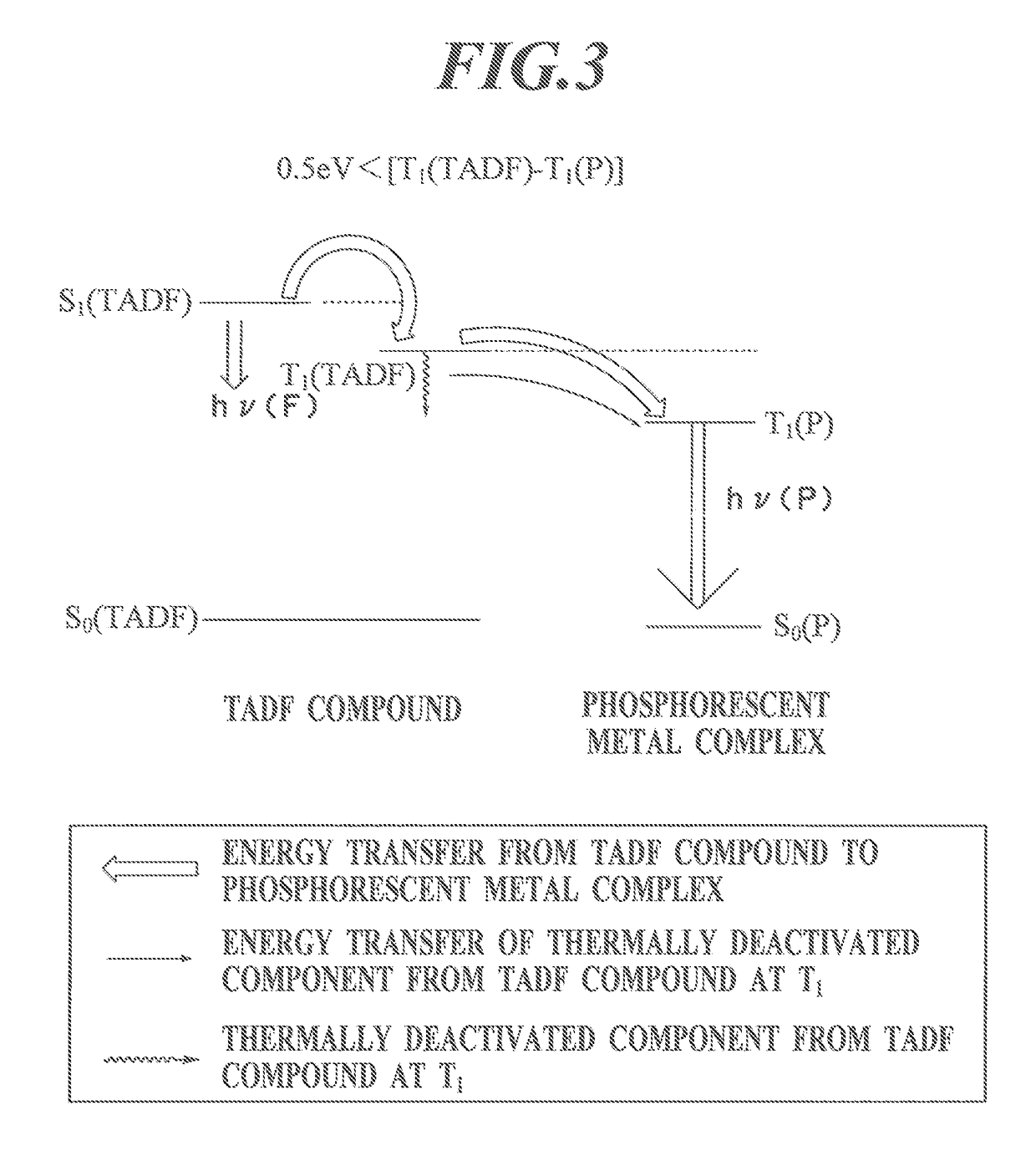Coating liquid for forming light emitting layer, organic electroluminescent element, method for manufacturing organic electroluminescent element, and lighting/display device
a technology coating liquids, which is applied in the direction of solid-state devices, chemistry apparatuses and processes, and light-emitting layers, can solve the problems of reducing molecular stability, reducing the luminescent efficiency of fluorescent materials, and reducing the service life of luminescent elements, so as to enhance the quantum efficiency of organic electroluminescent elements, enhance the quantum efficiency, and reduce the probability of t-t annihilation
- Summary
- Abstract
- Description
- Claims
- Application Information
AI Technical Summary
Benefits of technology
Problems solved by technology
Method used
Image
Examples
example 1
Preparation of Thin Film 1-1: Coating Film
[0323]A quartz substrate with dimensions of 50 mm×50 mm and a thickness of 0.7 mm was ultrasonically cleaned with isopropyl alcohol, was dried under a dry nitrogen gas stream, and was cleaned with UV / ozone for five minutes.
[0324]A diluted solution of a TADF compound 4,5-bis(carbazol-9-yl)-1,2-dicyanobenzene (2CzPN) in toluene was applied onto the substrate by spin coating at 500 rpm for 30 seconds to forma thin film. The thin film was dried at 120° C. for 30 minutes to prepare a thin film having a thickness of 40 nm.
Preparation of Thin Film 1-1: Deposited Film
[0325]A quartz substrate with dimensions of 50 mm×50 mm and a thickness of 0.7 mm was ultrasonically cleaned with isopropyl alcohol, was dried under a dry nitrogen gas stream, and was cleaned with UV / ozone for five minutes. This transparent substrate was fixed to a substrate holder of a commercially available vacuum deposition apparatus.
[0326]A TADF compound 2CzPN in an amount optimal t...
example 2
Preparation of Organic EL Element 2-1: Coating Film
(1.1) Preparation of Gas Barrier Support Substrate (Flexible Film)
[0341]A support substrate or a poly(ethylene naphthalate) film (made by Teijin DuPont Films Japan Limited, hereinafter abbreviated to PEN) was prepared. An inorganic gas barrier film made of SiOx (thickness: 500 nm) was continuously formed over the entire surface of PEN, on which an anode was formed in the subsequent step, with an atmospheric pressure plasma discharging system having a configuration described in Japanese Patent Application Laid-Open No. 2004-68143. A gas barrier flexible film was thereby prepared (oxygen permeation rate: 1×10−3 ml / m2·24 h·atm or less, moisture permeation rate: 1×10−6 g / m2·24 h or less).
(1.2) Deposition of Anode
[0342]Indium.tin oxide (ITO) was deposited on the gas barrier flexible film by sputtering into a film having a thickness of 120 nm. The film was patterned by photolithography into an anode.
[0343]The patterned anode had a light e...
example 3
Preparation of Organic EL Elements 3-1 to 3-22
[0361]Organic EL elements 3-1 to 3-22 were prepared as in Organic EL element 2-1 except that coating solutions containing different compounds in proportions shown in Table 8 were applied by a coating process to prepare luminous layers.
[0362]Organic EL elements 3-1 to 3-22 were prepared as in Organic EL element 2-1 except that different compounds were deposited at rates shown in Table 8 so that the deposition rates correspond to the composition ratios to prepare luminous layers. The proportion of the deposition rates of the materials was determined based on the mass proportion of the compounds other than the solvent.
[0363]
TABLE 8TADFHOSTCOM-COM-SOL-ORGANICTADFHOSTPOUND*1*2*3POUNDVENTELCOM-COM-[MASS [MASS [MASS [MASS [MASS [MASS ELEMENTPOUND*1*2*3POUNDSOLVENT%]%]%]%]%]%]NOTE3-12CzPN———S-57TOLUENE0.032———0.59899.370EXAMPLE3-24Cz IPN———S-57TOLUENE0.032———0.59899.370EXAMPLE3-34CzPN———S-57TOLUENE0.032———0.59899.370EXAMPLE3-44CzTPN———S-57TOLUEN...
PUM
| Property | Measurement | Unit |
|---|---|---|
| excited triplet energy level | aaaaa | aaaaa |
| triplet energy level | aaaaa | aaaaa |
| temperature | aaaaa | aaaaa |
Abstract
Description
Claims
Application Information
 Login to View More
Login to View More - R&D
- Intellectual Property
- Life Sciences
- Materials
- Tech Scout
- Unparalleled Data Quality
- Higher Quality Content
- 60% Fewer Hallucinations
Browse by: Latest US Patents, China's latest patents, Technical Efficacy Thesaurus, Application Domain, Technology Topic, Popular Technical Reports.
© 2025 PatSnap. All rights reserved.Legal|Privacy policy|Modern Slavery Act Transparency Statement|Sitemap|About US| Contact US: help@patsnap.com



